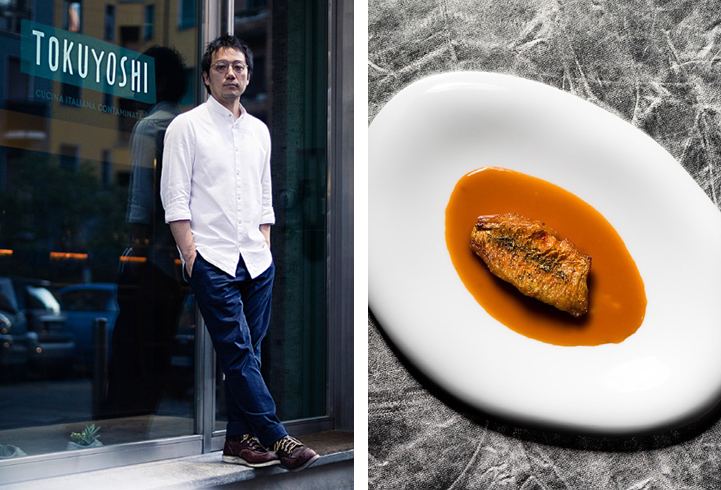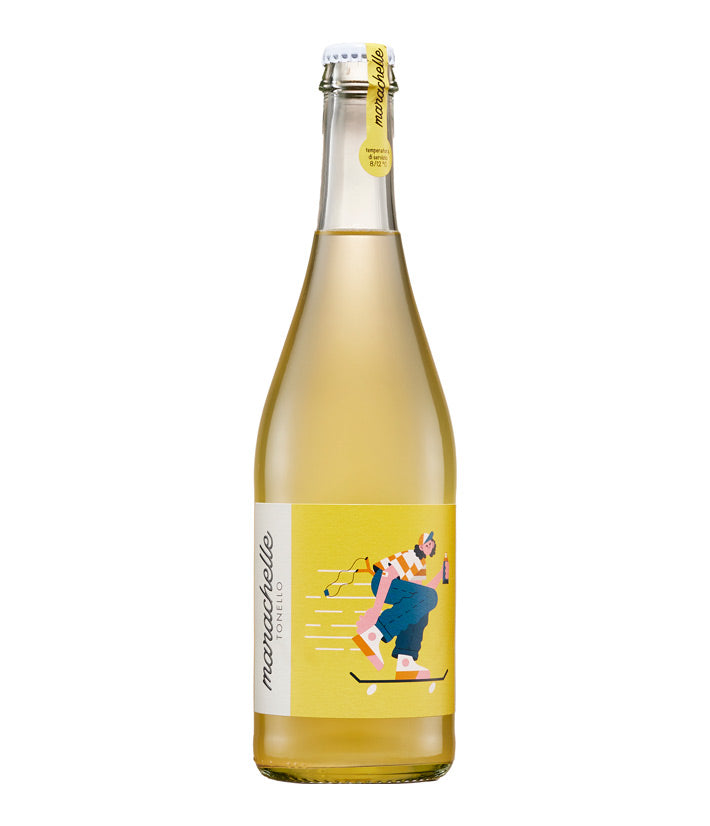
Yoji Tokuyoshi – An Italian chef from Japan
The recent opening of Japanese chef Yoji Tokuyoshi’s first solo venture had been eagerly awaited by gastronomes, food journalists and industry professionals alike. The new restaurant is in Milan, enriching the city’s already bustling dining scene.
A conversation with Yoji provided an insight into his culinary background, his thoughts on Italian food and contemporary cooking in general.
One of the issues that Yoji deals with on a daily basis is that many of his customers assume his cooking will necessarily include ingredients from his native Japan – in recent years, the interest in the idea of fusion cooking has literally exploded in Milano, sadly with very few legitimate practitioners. Diners visiting Yoji’s restaurant will find no trace of soy sauce, wasabi or pickled ginger, as Yoji only works with Italian ingredients and considers himself an Italian chef with a Japanese background. He defines his cooking as ‘cucina Italiana contaminata’, contaminated Italian food. The contamination he refers to is his being Japanese; the way he conceives flavour, presentation and the structure of a meal – there are no distinctions between antipasti, primi and secondi – reflects his oriental origins.
As so often happens in the restaurant industry, Yoji entered this world almost by accident, or destiny as he puts it. Hailing from a family of pharmacists, it was hoped Yoji would continue the family tradition. Not interested in preparing medical prescriptions, Yoji wagged a university exam, and his infuriated father showed him the door telling him not to return home. This marked the beginning of Yoji’s cooking career.
A cooking job was found in a Japanese restaurant that also specialised in both Italian and French food. Yoji remembers the fragrance of garlic sautéing in olive oil, the base of so many Italian dishes, as the spark that ignited his unwavering passion for Italian food. His next job was in an Italian restaurant in Tokyo that featured no less than eight different varieties of fresh egg pasta prepared daily – few restaurants in Italy are courageous enough to do this. To further his knowledge of Italian food, Yoji undertook a culinary pilgrimage to Italy. After several months, with no job and no money left, a dejected Yoji was resigned to returning to Japan. Waiting to board his flight from Malpensa, Yoji glimpsed a copy of the Espresso Restaurant guide. He opened the guide randomly and landed in the Emilia Romagna section where he noticed the review of Massimo Bottura’s Osteria Francescana. As a final attempt to stay in Italy and live his dream, he called the restaurant. Bottura told him to come on down – a tribute to Bottura’s open worldliness. The return ticket to Japan was binned and the rest is history.
Starting at the bottom of the kitchen rung, in a short time Yoji became Bottura’s sous chef and right-hand man. During the nine years Yoji spent at Francescana, the restaurant gained its first, second and third Michelin star, and in so doing became one of Italy’s gastronomic temples. Yoji’s time alongside Bottura provided him with a profound understanding of regional Italian cuisine in general, and in particular the cuisine of Emilia where pork and its derivatives, fresh egg pasta, balsamic vinegar and the fabled Parmigiano Reggiano play leading roles. Pork is one of Yoji’s favourite ingredients to cook, and tortellini in brodo is one of his favourite dishes to eat – the purity of flavour and restorative effect of this timeless dish is conceptually not unlike some of the miso-based broths that are so popular in Yoji's native Japan. Another important lesson Yoji attributes to Bottura is that a chef needs to present food with a discernible concept as well as a strong aesthetic sense – let's remember that Bottura claims the idea for the presentation of his bollito misto was inspired by the New York skyline. These lessons can be seen in Yoji's food today, where the natural colour of ingredients is used to create a strong chromatic effect.
Vegetables play an important part in Yoji’s cooking, in particular root vegetables. The dish ‘riso non riso’, rice not rice, is his tribute to the classic, but often banal, risotto alla Milanese – saffron risotto generally served with osso buco. Yoji’s interpretation is made without rice, using celeriac instead. The celeriac is cut to resemble grains of rice. The dish is then prepared in the classic way: the celeriac cooked in vegetable broth, finished with olive oil, instead of butter, and Parmigiano, and served with an osso buco reduction. The dish is both light and full of flavour, a characteristic of Yoji’s cooking, the earthiness of the celeriac perfectly balanced by the fragrance of saffron and the sweet meatiness of the osso buco reduction. This dish embodies what Yoji aims to achieve, creativity, an aesthetic sense and a modern interpretation of tradition.
Yoji sees Feran Adria and René Redzepi as the two most influential figures on young contemporary chefs. Adria distorted texture, while Redzepi got back to nature as a gatherer of wild ingredients. Both opened eyes to what could be done with a modern spirit and a deep understanding of tradition. Yoji pays passing tribute to these two figures but has chosen his own path. Unlike Adria, his manipulation is not molecular, but in the reinterpretation of Italian classics by adapting new ingredients to traditional recipes, Yoji's potato spaghetti are an example of this. Regarding the gatherer movement inspired by Redzepi, Yoji acknowledges that there is little to gather in Milano of edible quality. However, his dessert ‘cemento e terra’, cement and earth, with its bitumen coloured meringue, evokes the Milanese landscape. Among his peers, Yoji names Enrico Crippa of the Piazza Duomo in Alba, Ben Shewry of Attica in Melbourne and Alex Atala of D.O.M restaurant in San Paolo as chefs with whom he shares an affinity.
The dining room at Tokuyoshi is intimate, subdued colours and a large bar at which Yoji finishes dishes and interacts with his customers are features. Alfonso Bonvini – his surname aptly meaning ‘good wines’ – manages the restaurant and also holds the role of sommelier. Alfonso shares Yoji’s vision; his background is worldly, having plied his trade on all the world’s continents including Australia, at Pierre in Sydney and Pure South in Melbourne. The wine list compiled by Alfonso reflects his global experience. Small producers feature alongside established icons. Alfonso’s skill has been in compiling a list of wines that compliments Yoji’s food. The list also features a good selection of aged white and red wines, as well as an extensive list by the glass with intelligent, at times provocative, food matches suggested by Alfonso.
Tokuyoshi restaurant is in the centre of Milan and offers both a la carte and degustation menus at very reasonable prices.
Ristorante Tokuyoshi
Via San Calocero, 3
20123 Milano
Tel: + 39.02.84254626
Dinner: Tuesday to Sunday
